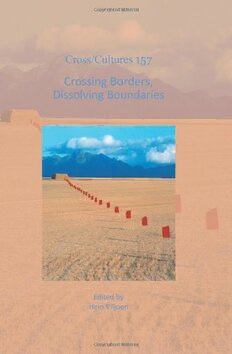
Crossing Borders, Dissolving Boundaries PDF
Preview Crossing Borders, Dissolving Boundaries
Crossing Borders, Dissolving Boundaries CROSS Readings in Post/Colonial ULTURES Literatures and Cultures in English 157 SERIES EDITORS Gordon Collier Bénédicte Ledent Geoffrey Davis (Giessen) (Liège) (Aachen) CO-FOUNDING EDITOR Hena Maes–Jelinek Crossing Borders, Dissolving Boundaries Edited by Hein Viljoen Amsterdam - New York, NY 2013 Cover Image Strijdom van der Merwe, Line of Red Flags between Wellington and Gouda (1994) Photo courtesy of the artist (www.strijdom.co.za) Cover design: Inge Baeten The paper on which this book is printed meets the requirements of “ISO 9706:1994, Information and documentation - Paper for documents - Requirements for permanence”. ISBN: 978-90-420-3638-3 E-Book ISBN: 978-94-012-0908-3 © Editions Rodopi B.V., Amsterdam – New York, NY 2013 Printed in The Netherlands Table of Contents Acknowledgements vii Illustrations ix Introduction xi Representing the Unpresentable: Between the Secular and the Spiritual in Gordimer’s Post-Apartheid Fiction ILEANA DIMITRIU 1 Narrative Dynamics and Boundaries: The Undermining of Event and Eventfulness in The Book of Happenstance by Ingrid Winterbach HEILNA DU PLOOY 27 Deneys Reitz and the Bounds of Self-Understanding JOHN GOUWS 51 Challenging and Negotiating National Borders: Sámi and Tornedalian AlterNative Literary History ANNE HEITH 75 The Visual Representation of the Boundary Between Past and Present: Chekhov’s The Cherry Orchard and Suzman’s The Free State LIDA KRÜGER 93 Earth as Home: Nature and Refuges/Living Spaces in Some Afrikaans Narratives SUSAN MEYER 113 Borders and Abjection in Triomf ADÉLE NEL 135 Body, Corpus, and Corpse: Delineating Henrik Ibsen in A.S. Byatt’s The Biographer’s Tale ELLEN REES 155 Pronouncing it the Porder: Ascribing Aesthetic Values to External and Internal National Borders in Frank A. Jenssen’s The Salt Bin JOHAN SCHIMANSKI 181 The Normal and the Carceral: Boundaries in Thomas Harris’s The Silence of the Lambs TONY ULLYATT 199 The Aid of Rhetoric and the Rhetoric of AIDS: Eben Venter’s Ek stamel ek sterwe PHIL VAN SCHALKWYK 229 Navigating the Interstitial: Boundaries in Lady Anne by Antjie Krog HEIN VILJOEN 251 Notes on the Contributors 279 Acknowledgements This book is the result of collaboration between the project Crossing Borders in and of Literature at the North-West University (Potchefstroom Campus) and the Border Poetics Research Group at Tromsø University and was partly developed during two boundary seminars that linked north and south by video. I am very grateful to the contributors for their enthusiastic participation in the project and for their patience with me. A special word of thanks to Gordon Collier, the technical editor of the Cross/Cultures series at Rodopi, for believing in the book and for his careful editing of the text. I also wish to thank Stephen Wolfe and Holger Pötzsch in Tromsø and Marita Wenzel, Betsie van der Westhuizen, Ralph Goodman, Cheryl Stobie, and Elzebet Stubbe in South Africa for participating in the seminars and loyally supporting the project. Rilette Swanepoel, Susan Smit–Marais, Attie de Lange, Andries Visagie, and Dolly Dlavane participated in the first boun- daries seminar. Many thanks to them as well. Tony Ullyatt language-edited most of the essays in the collection. For that I am very grateful. Thanks is also due to my research assistant, Bella du Toit, for her swift help with searches and queries and with converting the Harvard style into footnotes. The essays were all reviewed anonymously by two peer reviewers each. I would like to acknowledge the time and effort they gave to the project and the many helpful suggestions they made toward improving the essays. The project Crossing Borders in and of Literature was supported by the National Research Foundation of South Africa (NRF) from 2008 to 2011 and by the North-West University’s Research Unit: Languages and Literature in the South African Context. The Border Poetics Group contributed financially to the publication of the book. The support of these institutions is gratefully acknowledged. The views, findings, and conclusions expressed in this book are those of the authors and should not be attributed either to the NRF or to the Research Unit. viii CROSSING BORDERS, DISSOLVING BOUNDARIES (cid:97) The illustrations from Commando and from Deneys Reitz’s unpublished manuscript are used with the kind permission of the Brenthurst Library. Bengt Pohjanen, the publisher, kindly gave permission to use illustrations from the Tornedalian Literary History. We could not establish who the copyright holder is of the diagrams used in Ullyatt’s essay, but we will acknowledge any breach in any subsequent edi- tion. The extracts from Lady Anne are used with permission of the present copy- right holder, Human & Rousseau. Random House South Africa gave permis- sion to use the extracts from Down to My Last Skin. Strijdom van der Merwe allowed us to use a photo of his striking land-art work for the cover of the book. Thanks to him as well. HEIN VILJOEN POTCHEFSTROOM OCTOBER 2012 (cid:97) Illustrations Figure 1: Map of Reitz’s travels (Kommando, 316) 55 Figure 2: “Under British ‘Protection’ in the Springfontein Concentration Camp 1901,” Herinneringen van 1899–1902, MS 272/6, facing p. 604 67 Figure 3: “Lapp Prototype, relatively pure,” illustration in The Racial Characters of the Swedish Nation, ed. Herman B. Lundborg & F.J. Linders (1926). The photographs were taken by Gunhild Sandgren in 1925 76 Figure 4: Photograph of male models aiming at illustrating racial diffe- rentiation: illustration in The Racial Characters of the Swedish Nation, ed. Herman B. Lundborg & F.J. Linders (1926) 77 Figure 5: Map of Meänmaa, ‘our land’: back-cover illustration of Pohjanen and Johansson’s Tornedalian Finnish literary history 82 Figure 6: David Cooper’s model (Psychiatry and Anti-Psychiatry) adapted 201 Figure 7: David Cooper’s model (Psychiatry and Anti-Psychiatry) 202 Figure 8: Title page of Bentham’s Panopticon 217 (cid:97)
